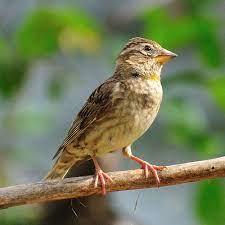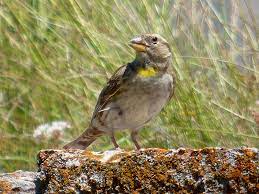The Rock Sparrow, scientifically known as Petronia petronia, is a captivating avian species that thrives in rocky landscapes, enchanting bird enthusiasts with its unique behaviors and adaptations. From its specialized habitat preferences to its distinct vocalizations, the Rock Sparrow stands as a testament to avian resilience. Join us on a journey to explore 24 fascinating facts about these charismatic birds, shedding light on their habitat, behaviors, and significance in the natural world.

1. Rocky Refuge: Rock Sparrows are well-adapted to rocky environments, often found nesting in crevices and cliffs.
2. Cliffside Nests: These birds are skilled nest builders, crafting their nests in cavities and crevices for protection.
3. Territorial Defenders: Rock Sparrows are known to fiercely defend their nesting territories against intruders.
4. Wide Distribution: These birds can be found across a vast range, from Europe to parts of Asia and Africa.
5. Cryptic Plumage: Their plumage blends seamlessly with rocky backgrounds, providing effective camouflage.
6. Social Gatherings: Rock Sparrows are often seen in small flocks during non-breeding seasons, engaging in social behaviors.
7. Dietary Diversity: Their diet consists of a variety of seeds, insects, and plant matter, making them versatile foragers.
8. Specialized Beaks: Their conical beaks are adapted for cracking open seeds and extracting insects from crevices.
9. Territorial Songsters: Rock Sparrows communicate using a range of melodious songs that serve to establish and defend territories.
10. Nomadic Movements: Some populations of Rock Sparrows undertake seasonal migrations in search of suitable nesting sites and food sources.
11. Monogamous Bonds: These birds form monogamous pairs during the breeding season, working together to raise their young.
12. High-Altitude Dwellers: In mountainous regions, Rock Sparrows can be found at elevations reaching up to 3,000 meters.
13. Hardy Survivors: Their adaptations to rocky landscapes and variable weather conditions contribute to their survival.
14. Niche Specialists: Rock Sparrows are ecologically important as they exploit habitats that are less preferred by other bird species.
15. Breeding Habits: They typically breed in spring and summer, taking advantage of the increased availability of food.
16. Molt Magic: Rock Sparrows undergo molting processes to maintain their plumage, adapting to changing seasons.
17. Behavioral Variations: Behavior patterns vary among different populations, showcasing their adaptability.
18. Population Declines: Habitat loss and human disturbance have led to declining populations in some regions.
19. Migratory Strategies: Some populations migrate across long distances to reach their breeding and wintering grounds.
20. Conservation Efforts: Protecting their rocky habitats and nesting sites is crucial for their long-term survival.
21. Ecological Connections: These birds contribute to seed dispersal and insect control, benefiting their ecosystems.
22. Avian Artists: Rock Sparrows’ musical calls and songs add a melodious ambiance to their rocky habitats.
23. Subspecies Diversity: The Rock Sparrow exhibits variations in plumage and behaviors across different subspecies.
24. Rocky Inspiration: Their ability to thrive in challenging environments serves as an inspiration for resilience and adaptation.



















Add Comment